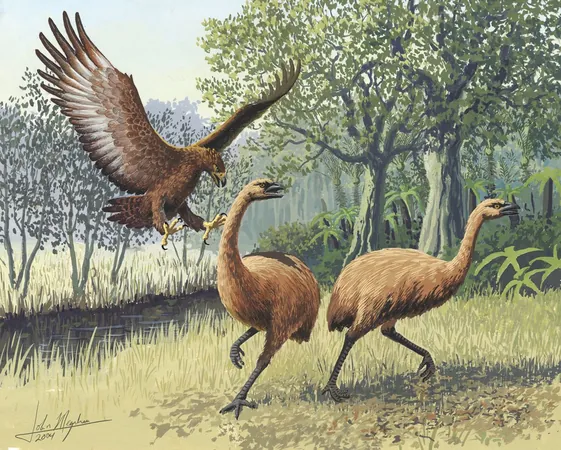
Unveiling the Terrifying Legacy of Haast's Eagle and Its Feathered Relatives
2024-11-01
Author: Siti
The Titan of the Skies: Haast's Eagle
At a staggering weight of 18 kilograms, Haast's eagle (Hieraaetus moorei) was the largest eagle to have ever existed. Its wingspan reached nearly 3 meters, casting a fearsome shadow across New Zealand's South Island from its arrival around 1,000 years ago until its extinction around 1445. This apex predator was not just a bird; it was a living nightmare for the flightless moas and other large birds that fell prey to its lethal hunting skills.
Feasting on Giants: The Diet of Haast's Eagle
Haast's eagle had a diverse menu that included ducks, swans, and the colossal moa, which could weigh up to 200 kilograms. Fossil evidence and Māori cave art suggest that Haast's eagle employed brutal techniques, possibly using its powerful talons and curved beak to disembowel prey and access vital organs, similar to the feeding habits of vultures today.
Interestingly, while tales of Haast's eagle hunting humans loom large in folklore, there is no concrete proof to support these claims. The Māori legends of a fearsome creature known as pouākai drew inspiration from the eagle's formidable size, yet scientific evidence pinpoints that its primary diet consisted of large flightless birds until they, too, vanished.
Other Winged Predators: A Take on Evolution
Haast's eagle is not the only giant raptor to have graced our skies. The recently identified Dynatoaetus gaffae, or Gaff's powerful eagle, boasted a weight nearing 12 kilograms and may have sported even longer talons. Furthermore, the extinct Cuban giant eagle, Gigantohierax, hunted prey including giant rats and sloths for thousands of years, showcasing the incredible diversity of large predatory eagles that once existed.
Modern Eagles and Their Capabilities
Fast forward to today, and the harpy eagle, weighing approximately 10 kilograms, still holds the title of the heaviest eagle in existence—though it's clear that no living eagle can resemble the sheer ferocity of Haast’s eagle. Interestingly, stories surrounding the crowned eagle, a smaller raptor at 4.5 kilograms, suggest it has attacked young children in recent times. This sharp-toothed hunter has even been implicated in the death of ancient hominins, including Australopithecus africanus, who bore telltale puncture wounds consistent with eagle predation.
A Legacy of Power and Fear
From the towering Haast’s eagle to its lesser-known relatives, the lineage of formidable eagles is a fascinating chapter of the natural world. While many of these incredible birds have vanished into history, they leave behind an enduring legacy that influences our understanding of predatory dynamics in the animal kingdom. Today’s powerful eagles, though less gigantic than their extinct ancestors, continue to inspire awe and serve as a reminder of the complex web of life that once thrived.


 Brasil (PT)
Brasil (PT)
 Canada (EN)
Canada (EN)
 Chile (ES)
Chile (ES)
 Česko (CS)
Česko (CS)
 대한민국 (KO)
대한민국 (KO)
 España (ES)
España (ES)
 France (FR)
France (FR)
 Hong Kong (EN)
Hong Kong (EN)
 Italia (IT)
Italia (IT)
 日本 (JA)
日本 (JA)
 Magyarország (HU)
Magyarország (HU)
 Norge (NO)
Norge (NO)
 Polska (PL)
Polska (PL)
 Schweiz (DE)
Schweiz (DE)
 Singapore (EN)
Singapore (EN)
 Sverige (SV)
Sverige (SV)
 Suomi (FI)
Suomi (FI)
 Türkiye (TR)
Türkiye (TR)
 الإمارات العربية المتحدة (AR)
الإمارات العربية المتحدة (AR)